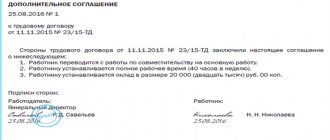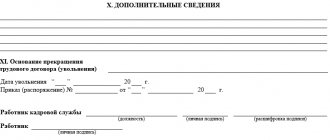When is it needed?
Staffing table (form T-3) is a document reflecting the structure of the organization, the subordination of departments, fixing the number of employees and the form of remuneration for each position.
Replacement of the staffing table is necessary in the following cases:
- During the structural reorganization of the enterprise.
- When there is a change in the processes of the organization.
- When optimizing personnel in accordance with the law.
Thus, a report about a decrease in profitability and a lack of raw materials can become a basis for job reductions, and a memo from a manager about an increase in workload in connection with the launch of a new direction can contribute to the expansion of staff.
An inveterate latecomer
Dmitry Pukhtin and Kirill Medvedev note that frequent absences during working hours are an alarming signal for a manager. If an employee frequently asks “I’ll be back later today” or “I need to leave work early,” and cannot clearly argue the reason for the abrupt change in daily routine, then this is one of the indirect evidence against the fugitive.
Of course, it will be difficult to track the frequent absences of an employee who has a flexible schedule in the company, explains Pukhtin and invites employers to note one more fact, which he did not attach much importance to at the time.
— Employees who are about to quit get sick more often than usual and use their time off chaotically. So, in their free time from work, they look for a new place.
If changes occur, is a new document always necessary?
The staffing table is approved for the calendar year . The law does not establish the permissible number of updates. Occurring events do not always require a change in the T-3 form. For example, in the case of minor adjustments in the structure, salary increases or the introduction of new positions, it is enough to issue an order for changes and be guided by it. The order must reflect the reasons for the changes made and the wording of the adjustments.
Global structure updates, massive salary increases, and changes in job titles require the issuance of an order approving a new staffing table. A new document containing all changes is approved by the head of the organization. The fact of adoption of the staffing table is recorded by an entry in the journal for registering orders for core activities.
Reasons why newbies don't work long
To understand why new employees quit, they look at the regulations for young people joining a little-known team.
At the right enterprise, introductory courses and trainings are carried out, mentors are assigned to monitor the actions of the new employee. There is a significant difference between an inexperienced specialist joining a team and a qualified employee who has experience in other organizations. In the latter case, the stereotypes that a person has developed often do not coincide with the routine that exists at the new enterprise. There are 3 possible scenarios:
- the experience of interacting with clients and co-workers does not contradict the norms and rules prevailing in production: adaptation is successful;
- a person is ready to change and adapt to changing conditions in order to continue working in a team;
- the newcomer takes the initiative, tries to change corporate foundations, and pushes his own line.
In the latter case, the employee should think about it, because the manager has a sufficient arsenal at his disposal to ensure the development of the enterprise and the team. The explanatory work of the HR department and the executive director helps the newcomer to comfortably join the organization and understand the specifics of the company’s activities.
The reason a new employee leaves a company is often a lack of recognition of personal success. And this is not necessarily expressed in material form - there are also free methods of encouragement.
Sometimes the unethical behavior of a manager with partners and clients pushes a principled newcomer to terminate the contract. Excessive bureaucratization of the decision-making process also affects the likelihood of dismissal of an employee with little experience.
In what cases does nothing need to be done?
Is it necessary to change the document when dismissing an employee? Not all personnel movements require staffing updates .
If an employee goes on maternity leave and an external candidate is hired in his place, adjustment of the T-3 form is not necessary, because the number of staff units has not changed.
If an employee resigns and a vacancy opens for this position, the staffing table does not need to be updated. If the vacancy is not filled within 14 days, you must submit information to the Employment Center (Clause 3 of Article 25 of the Law on Employment in the Russian Federation No. 1032-1 of April 19, 1991).
Identical positions should be given the same salaries . If you need to pay different salaries to two specialists, you must indicate two positions in the staffing table: specialist and chief specialist
Dismissal at the request of an employee
An employee has the right to terminate the employment relationship at any time. To do this he needs:
- fill out an application for resignation of your own free will 2 weeks before leaving;
- work the assigned days;
- complete the transfer of affairs to another employee, if such a procedure is provided in the organization.
It does not matter what contract was concluded when entering the job - fixed-term or indefinite. In any case, the employee’s desire is decisive, and the employer has no legal grounds to interfere with him.
The application is written addressed to the manager with the wording: “I ask you to dismiss me at my own request, “XX” month in words XXXX year”, the current date and signature.
If an employee leaves without working, he must include in the application the reason for dismissal:
- retirement;
- enrollment in studies;
- moving to another area;
- transfer of a spouse to another duty station/abroad;
- violation of the law, terms of the employment contract by the employer.
In such cases, dismissal occurs on the date specified by the applicant. If required, a supporting document (certificate from the institute, transfer order, etc.) must be attached to the application. An employee can leave “one day” without a good reason if the employer meets him and allows him not to work.
Without observing the two-week period, you can dismiss an employee on vacation if he submitted an application before it began or during the vacation, but no later than 14 days before going to work. Then the first working day after vacation will be considered the date of termination of the employment contract.
Employees on a probationary period, signed under a fixed-term employment contract for a period of up to 2 months, and seasonal workers work not the standard 14, but only 3 days.
From the employer's perspective, the procedure for voluntary dismissal looks like this:
- receipt of an application endorsed by the head of the company;
- creating an order;
- making an entry in the work book;
- full settlement with the employee regarding wages;
- preparation of documents necessary for further employment (2-NDFL certificates, certificate of earnings for 2 years and others, at the request of the employee).
Whatever the reason for leaving, the personnel documents will indicate the same reason under which article to dismiss the employee - Art. 77 Labor Code of the Russian Federation. On the day of dismissal, the employee reads the order and receives a work book. Until this moment, a person can change his mind and withdraw the application if a replacement has not yet been invited to take his place, which “cannot be turned back.”
How to change a document?
- The first step in the process of updating the T-3 form is a memo about the need to adjust the structure, expand the staff, etc.
- Next, you need to decide whether the changes are significant and will require the approval of a new document, or whether it is enough to make changes to the form that records the structure and size of the organization. In accordance with the decision, an order is being prepared either “to approve the staffing table” or “to make changes.”
- The order to amend the T-3 form contains two dates - the date of signing and the date of entry into force of the decisions made. Indicates responsible executors. Signed by the manager.
- The order to approve the new T-3 form obliges to create a new document form with a number following the number of the current edition.
If a new version of T-3 is introduced in connection with a reduction in staff, it cannot contain vacant positions that could be offered to dismissed employees.
The new version of the staffing table can be updated after 2 months . The document can be approved once and be valid for many years. Or it can be created anew or adjusted countless times.
In modern conditions, when a document is created electronically, it is not difficult to create a new form and assign it the next sequential number. All forms, valid and expired, should be kept in a safe place.
What should a personnel officer do if an employee disappears?
Work under the Labor Code of the Russian Federation requires discipline from both the employee and the employer. But what should a personnel officer do if an employee suddenly disappears? How many days to wait for the missing person? When and how to fire? In our article we revealed the main nuances of the topic.
An employee may be absent from work for various reasons. It happens that people have unforeseen circumstances that are quite difficult and do not allow them to return to everyday life. In all situations, employers have to find out the reasons for absenteeism and sometimes even fire the missing employee.
How long can an employer wait for a missing employee to show up?
The Labor Code does not establish an obligation for an employee to notify the employer of absence from work. But such an obligation can be provided for in a local document of the organization, for example, internal labor regulations. And employees will have to comply with it, since by virtue of Art. 21 of the Labor Code of the Russian Federation, an employee must comply with labor discipline and internal labor regulations. However, this will not give the employer much, since it will still not be possible to fire an employee for absenteeism if he did not report his absence on time. Any court will recognize such dismissal as illegal if the reason for the employee’s absence is considered valid.
In fact, employees usually warn the employer that they will not come to work or have not come to work for one reason or another. Well, if this does not happen, the employer has to find out the reason.
How long can an employer wait for a missing employee to appear? There is no answer to this question in labor legislation.
First of all, the personnel officer or immediate supervisor calls the employee by phone (cell phone, landline). If it was not possible to find out the reason on the first day, it is too early to draw conclusions that the employee is absent, but the fact of his absence from the workplace will have to be recorded. To do this, you need to draw up an act in any form - it is drawn up by a commission of at least three employees.
At first, it is advisable to draw up such acts daily. Then, if the employee does not show up, you can compile them once every few days or once a week. Don’t forget to also note the employee’s absence on the time sheet. The days when he was absent will be indicated by the letter code “NN” - failure to appear for unknown reasons.
If the employee has not gotten in touch, it is worth contacting the employee’s close relatives and friends, if possible. It also makes sense to go to the employee’s home. If these actions do not lead to anything, you should send him a letter (valuable with an inventory of the attachment and notification) or a telegram demanding an explanation of the reasons for absence from work.
Keep in mind that if an employee is registered at one address and lives at another, letters should be sent to both addresses. Moreover, you can not limit yourself to one letter, but send them, for example, every week for a month.
If no answers were received from the employee, and the notifications were returned due to the absence of the addressee or after the expiration of the storage period at the post office, you need to draw up a statement about the impossibility of receiving an explanation.
Nobody, by and large, obliges the employer to carry out a further search for an employee who has been absent for a long time. Many simply fire such employees for absenteeism. But there is a risk: the employee may return to work with evidence that he was absent for a valid reason. And then, by a court decision, he will have to not only be reinstated at work, but also pay all amounts due to him and compensate for the time of forced absence. Therefore, the employer must still have grounds for dismissal.
Are there grounds for dismissing a missing employee for long absence?
The specifics of dismissing a missing employee who does not go to work for a long time are not defined by law. You can fire him if there are documents that confirm the reason for his absence. The procedure for registering dismissal will depend on this reason. So, if you have a court decision recognizing the employee as missing or documents confirming the fact of the employee’s death, formalize the dismissal on the basis of clause 6, part 1, art. 83 of the Labor Code of the Russian Federation, taking into account the peculiarities inherent in each case. If there are no documents justifying the employee’s long-term absence and it is not possible to establish the reasons for such absence, we do not recommend filing a dismissal before the employee returns to work.
We do not recommend firing an employee for long absences until he returns to work.
The fact is that you may not be able to establish the real reasons for its absence. But they may turn out to be respectful, it’s just that the employee could not warn you about it. For example, the employee was absent due to being in custody or was in a hospital in serious condition and was not able to inform you about it.
It is important to note that dismissal for absenteeism is a disciplinary sanction (Part 3 of Article 192 of the Labor Code of the Russian Federation). Therefore, it is necessary to follow the procedure for bringing to disciplinary liability. In particular, before dismissal, you need to request from the employee a written explanation of the reason for absence (Part 1 of Article 193 of the Labor Code of the Russian Federation). But if he disappears (does not get in touch), this is difficult to do. And without a written explanation, it is difficult to determine whether the employee was absent without a good reason, that is, whether absenteeism occurs and, accordingly, whether dismissal is permissible under paragraphs. “a” clause 6, part 1, art. 81 Labor Code of the Russian Federation.
Therefore, it is better to wait until the employee returns to work to find out the reasons for his absence, and then follow the procedure for applying disciplinary action. Moreover, waiting does not incur any financial or other costs for you.
How to find an employee?
So, the first thing you need to do to find an employee is to contact the police department with a request to conduct a search (Article 12 of the Federal Law of 02/07/2011 No. Z-FZ “On the Police”). After submitting such an application, the employer will have in his hands a tear-off notification coupon confirming his application (Order of the Ministry of Internal Affairs of the Russian Federation dated August 29, 2014 No. 736 “On approval of the Instructions on the procedure for receiving, registering and resolving in the territorial bodies of the Ministry of Internal Affairs of the Russian Federation applications and reports of crimes, administrative offenses, incidents”).
For your information. During the search, the employee may be found in a hospital, in custody, etc. This will confirm that he has valid reasons for being absent from work.
If the employee has no relatives, then by virtue of Art. 42 of the Civil Code of the Russian Federation, the employer himself has the right to apply to the court to recognize the employee as missing. This can be done only if at the employee’s place of residence there is no information about his place of stay during the year. This period is calculated from the moment the last information about the person is received.
The application is submitted to the court at the place of residence of the employee or at the location of the interested person, that is, the employer (Article 276 of the Code of Civil Procedure of the Russian Federation).
According to Art. 277 of the Code of Civil Procedure of the Russian Federation, in an application to recognize a citizen as missing, it must indicate for what purpose the applicant needs to recognize the citizen as missing, and the circumstances confirming the citizen’s unknown absence must also be stated.
For the employer, the purpose of recognizing an employee as missing is to terminate the employment contract under clause 6, part 1, art. 83 Labor Code of the Russian Federation.
What is the procedure for dismissing a missing (unknown) employee?
The procedure for dismissing a missing (unknown) employee is as follows. Dismissal is carried out on the basis of a court decision declaring the employee missing. You need to fill out standard dismissal documents (in particular, a dismissal order and a work book).
Terminate the employment contract on the date the specified court decision enters into legal force. But the dismissal documents may have to be drawn up later, in case you received the court decision after its entry into force.
Give the work record book and amounts due to the employee on the date of dismissal to his relatives (other persons) only if this is provided for by a court decision.
The date of dismissal of an employee recognized by the court as missing is the date the corresponding court decision enters into legal force. This follows from clause 6, part 1, art. 83 Labor Code of the Russian Federation, para. 1 tbsp. 42 Civil Code of the Russian Federation, Part 2, Art. 13, art. 210 Code of Civil Procedure of the Russian Federation, Letters of Rostrud dated 09/05/2006 No. 1552-6.
You can check the date of entry into force of the court decision on the official website of this court.
Execute the dismissal documents (in particular, the order and work book) only when you have a court decision in your hands, but not before it comes into force. In practice, it is possible that such documents will have to be drawn up later than the date of dismissal. For example, if a relative of a missing employee contacts you with such a decision some time after it came into force. Then it is better to draw up the dismissal documents on the day the court decision is presented to you.
In this case, in order to avoid questions from regulatory authorities, we recommend that you draw up a report in any form, recording in it the date you received the court decision. Such an act will help you justify the execution of dismissal documents later than the date of termination of the employment contract.
What if a worker is found?
Situations in life are different, and an employee declared missing in action may turn up. And it is possible that he will want to return to his previous job. What should the employer do in this case?
First of all, the employee must be sent to court with an application to cancel the court decision declaring him missing (Article 280 of the Code of Civil Procedure of the Russian Federation). Then you need to give him a work book, if it has not been handed over to relatives.
After this, you can consider whether to take the employee back or not (after all, the employer does not have such an obligation; the employee was fired legally). Of course, if a misfortune really happened to him, you can meet him halfway, but if he behaved irresponsibly and simply decided to “change the situation,” it’s up to you to decide.
And if you decide to hire him back, the question will arise: what to do with the employee who has already been hired for this position? There are no legal grounds to offer him a transfer to another position, as well as grounds for dismissal. Therefore, everything will have to be decided by agreement with the employees on who is offered which vacant position.
If a compromise is reached, the employee who shows up is hired in accordance with the general procedure: all necessary documents are requested in accordance with Art. 65 of the Labor Code of the Russian Federation, draw up an employment contract, etc.
As you can see, the procedure for dismissing a missing employee is quite troublesome (fortunately, not too frequent). If the missing person has relatives, then the main concerns will fall on their shoulders, and you will be left with the dismissal based on a court decision. When there are no relatives, the employer will have to take care of everything. And special care should be taken in the first stage - finding out the reasons for the employee’s absence. Perhaps everything will be resolved at this stage if the employee simply skips work. Then he can be fired for absenteeism. If the employee really disappeared, then the employer will have to act according to the proposed scheme.
In any case, we do not recommend dismissing an employee for absenteeism if the reason for his absence is unknown and the employer is unable to comply with the established dismissal procedure. Under these circumstances, there is a high probability that the dismissal will be considered illegal and the employer, as a result, will have to reinstate the employee at work and pay him the average salary for the entire period of forced absence. Other consequences unfavorable for the employer are also possible.
Consequences
Making changes inevitably entails the need for subsequent actions, the initiation of procedures that will cause changes in the working conditions of employees and require the preparation of personnel documents. You should familiarize yourself with the order to amend the T-3 form against signature . It is necessary to inform those responsible for subsequent actions and those who are directly affected by these changes.
If it is planned to remove some positions from the staffing table, then the date of updating the document should allow the owner to warn employees about dismissal due to reduction within the time frame established by law - 2 months in advance (Part 2 of Article 180 of the Labor Code of the Russian Federation).
I'm not afraid of layoffs!
It must be said that Russians are quite afraid that they might be fired for no apparent reason. Back in the post-crisis year of 2009, 60% of employed Russians, according to the recruiting portal Superjob, would like to be able to insure themselves against dismissal. By the way, in England, for example, there is a law that allows Britons to insure themselves against dismissal and reduction in income. If a client is fired through no fault of his own, the insurer will compensate for the difference in income if the person has to switch to a lower-paid job.
Reasons for changes
- Introduction of new positions.
- Issue an order on the introduction of new positions indicating the number of units to be introduced and tariff rates, salaries and start date.
- Familiarize the HR department employees responsible for creating job descriptions with the order against signature.
- Salary increase.
- An order to increase salaries, allowances and additional payments, indicating the positions that these changes affect and the specific amounts of salaries and additional payments.
- Under signature, familiarize the HR department employees and employees holding positions whose salaries are changing with the order.
- Sign additional agreements to employment contracts with employees whose interests are affected by the changes (Article 57 of the Labor Code of the Russian Federation).
- Elimination or reduction.
- Issue an order for liquidation/reduction with justification for the need for liquidation/reduction. Indicate the list of positions and the number of staff units subject to dismissal.
- Familiarize the order with all employees involved in the procedure: trade union members, personnel service, planning department.
- Inform the dismissed employees in writing by sending notices 2 months before the date of entry into force of the changes.
It is necessary to inform the employee in writing about upcoming changes if:
- salary changes;
- positions are renamed;
- staff is being reduced;
- in other cases, changes in working conditions that are included in the Employment Contract.
Reasons for leaving the best specialists
Almost always, the main reason for searching for a new company to continue successful activities in the specialty was and still is the salary, or more precisely, its level. Regarding the best employees, why people who have earned authority in the enterprise leave is increasingly more complicated. They know their worth in the labor market and select an appropriately paid job, taking into account additional factors: prospects for career growth, an expanded package of social opportunities, interesting job responsibilities.
Personal circumstances
It is not difficult to detect changes in an employee’s behavior if you are interested in his daily life. Nobody likes to work blindly; talented specialists will not waste time on useless work . Reasons for dismissal due to the internal nature of a person include:
- A feeling of stagnation: the employee is satisfied with everything, but the feeling that he can do more does not leave the specialist - the foreman has clearly outgrown his position.
- The difference between a person’s work style and the corporate direction of the company. If an employee has a creative imagination and a habit of independence, then it is difficult for him to adapt to clearly defined regulations with control functions.
- Loss of interest in work, emotional burnout, feeling tired and depressed. Monotonous work and an overly oppressive environment lead to such consequences.
- The desire to organize your own business is a common occurrence. Having gained experience, a specialist gains confidence in his strengths and capabilities. As a result, enterprising employees create their own businesses.
- The employee’s disloyalty towards the company, management, and colleagues. This is a character trait of people who tend to express dissatisfaction openly. When faced with opposition, they boldly break with the company.
The key to an employee’s long-term work at the enterprise is a direct and trusting relationship with the manager. Both parties have equal rights regulated by the Labor Code of the Russian Federation.
External Determinants
Personnel turnover is influenced by the quality of management decisions of the enterprise management, ensuring a balance between work and rest time. Employees attach greater importance to relationships with their immediate supervisor than to the regime established at work. External reasons for dismissal of the best workers include:
- Impossibility of normal communication with superiors. Since an agreement cannot be reached, it is easier for an employee to move to another company: good specialists are in demand at industrial enterprises. This circumstance is taken into account when a manager and a subordinate must interact under production conditions.
- Relations between co-workers - ridicule and envy will inevitably become an impetus for an employee to leave due to a feeling of discomfort.
- Achieving a professional or job ceiling within the company. For a successful employee, this certainly happens. The responsibility of the manager is to anticipate such situations, organize related production for the development of the company and the promotion of personnel.
- Failure to recognize the merits of an employee on the part of the company administration is something that every person needs attention.
- The absence of an ultimate goal, a task for all the organization’s activities: working blindly is ineffective. The employee must understand the results of his skill.
- Territorial location. When a lot of time is spent on the road, there is a desire to move to a similar enterprise located nearby with more comfortable conditions.
A single reason rarely initiates the dismissal of the best employees; usually there are several motives. It is in the interests of the company to retain a successful specialist, because his departure will entail the loss of the entire team and clients of the company.










